One evening in the 1980s, photographer Kathy Shorr was at her home in Greenwich Village, New York, alone with her toddler, when two men dressed as postmen turned up at the door. The intruders forced their way into the house and burgled it, all the while threatening Shorr and her daughter with a gun.
What had always been a distant, abstract thought suddenly became a tangible and terrifying reality. “I know what it feels like to have a gun pointed at you and the person closest to you,” Shorr says. “That’s a feeling that you never want to experience again, and you don’t wish on anybody. It’s a complete loss of control over your life, and somebody else taking that control.” Although both were unharmed, the incident left them shaken. “It’s not something I think about all the time, but an experience like that goes into your psyche – you can recall it and still feel it. It’s part of me.”
Years later, when she was working as a teacher, Shorr started noticing that her students were wearing laminated photographs to commemorate friends and family who had been killed with guns, turning the victims, she felt, into “folk heroes”. She became interested in the idea of what happened to the people who survived being shot, so at the end of 2013 she embarked on an ambitious two-and-a-half-year project: photographing 101 survivors of gun violence in the place where they were shot. “Lucky” is a word that often comes up in relation to those left alive, but the photos document the injuries, scars and trauma that regularly follow a shooting; one spread of pictures shows those who are now using wheelchairs.

Although initially wary of bringing back painful memories, Shorr found that the people she approached were enthusiastic about speaking to her. By the end of the project, survivors were getting in touch asking to be included; only two of those contacted declined to take part. Going back to be photographed was often the first time the subjects had returned to the scene of the shooting, so Shorr made sure she spoke to them for at least half an hour – one conversation went on for three hours – to establish a rapport and to make sure they were ready.
What frequently followed the photo was a sense of release, says Shorr: “I heard from so many people how cathartic it was to go back to the place, take back the space and make it theirs.” One girl says the project “gave [her] a sense of closure”. Many of the subjects have since become Shorr’s friends: “I feel a real bond with them, a connection: they shared probably the most traumatic thing that’s ever happened to them with me. They did it because they wanted to help other people.”
In 2013 there were 84,258 nonfatal injuries caused by firearms in the US, affecting people of all ages, ethnicities and backgrounds. The book reflects this, with victims aged from eight to 80 all over the country, ranging from bishops to accountants, professors to sex workers, rock musicians to third graders. The locations, too, are familiar: schools, gyms, churches, shopping centres. “Never in my wildest dreams did I think I would be shot with a gun,” says one survivor in the book, Mariam Paré´. “I had lived my entire life thinking that was the type of thing that happened to other people in other parts of the country, or to people in books or TV. Until, one day, it happened to me.”
Behind every photo is a different tragedy: the people who pulled the triggers were spouses, siblings, strangers, policemen. One woman was shot by her ex-husband as she picked up her daughters from nursery school: he shot her 14 times, using two guns. Another woman – a fifth of those photographed are domestic violence survivors – was injured by her abusive boyfriend in a botched murder-suicide plan. A six-year-old boy at a Jewish day camp was shot by a neo-Nazi.
But what could have been a bleak, emotionally draining project ended up being a life-affirming one. “I was amazed by how these people had moved on with their lives and got stronger and more empathetic. Every time I left a person I felt in awe of how courageous and determined they were, and I came away from the project feeling the goodness and the strength of the survivors.”
Shorr felt it was especially important to include photos of gun owners, army sergeants and National Rifle Association members. “My feeling is that responsible gun owners are the people that can do something to make it harder for people who shouldn’t have guns to get them.” According to a study she references in the book, an estimated 9% of Americans with anger issues have access to a gun. When I ask how the current administration is going to change gun control laws, she lets out a forlorn laugh. “I thought things were bad, but they’ve got progressively worse. Right now, people can’t talk to each other, they can’t see the other side. The book is meant to create a dialogue. We’re never going to come up with a solution that both sides will be totally happy with, but there has got to be compromise about this issue.”
Kathy Shorr’s Shot: 101 Survivors of Gun Violence in America (powerHouse Books) is out now; shotproject.org
Shyrica Wesley: ‘I don’t see myself as a victim or a survivor – I see myself as an example’
Dallas police sergeant Shyrica Wesley, 38, (pictured above) was in a parking lot at Walmart when her husband shot her in the face before killing himself. She has seven children and remarried eight years ago
This year it’ll be 10 years since I was shot. It happened 26 August 2007. I had been going through a separation with my husband. He was very abusive, physically and emotionally. I came here from Louisiana after [Hurricane] Katrina, and I already had four kids when I met him. I didn’t really know anyone. I didn’t really know my options. Once I left him, he started following me. He would show up at my job, anything to have some control over me.
It happened on a Sunday. I was going to Walmart to pick up stuff for my kids for school. The store was maybe five minutes from where we lived. He followed me in his car and sped ahead of mine. When I got caught at a red light, he got out of his vehicle and jumped in with me.
I pulled into the parking lot. I remember the conversation. He was like, “Is there anything I can do? I can’t lose my wife, I can’t live in this world without my wife.” And I just told him, “No, I’m done. I can’t do it any more.”
I was getting ready to get out [of the car] when I received a call that two of my co-workers had died. My husband then started trying to console me. And I said, “No. I want you to leave me alone.” I wiped my face from crying and pulled the latch on the door, and then he shot me. But I didn’t know he’d shot me. I thought he’d punched me because I was used to physical abuse by then and I didn’t hear a gun go off. My face was just vibrating.
I continued getting out of the car and stood up and said, “Somebody help me. Lord, help me.” And I remember a lady saying, “Somebody get me a cell phone, she’s been shot.” When she said that, I put my hand up to the right side of my head and my index finger actually went into the hole where he had shot me. And I started panicking.
I could see him looking out the back window of his car. He was just looking and looking. By the grace of God, there were some paramedics in Walmart and they saw me collapse on the ground.
When I collapsed, my husband thought I had died. He turned around, and the car moved. And the lady with me said, “You have kids in the car.” I said, “No ma’am, I don’t, don’t leave, you’re the one that’s keeping me alert.” The paramedics were trying to get an IV started in my arm, and the woman pulled away and went to the side of the car, as she thought there were kids in there. She told me later that he said, “My wife’s gone, I can’t live in this world without my wife.” He put the gun into his mouth and pulled the trigger. The last words I remember before I blanked out were her saying, “He dead, he dead, he just shot himself!”
He shot me at point-blank range in the right side of my temple. It broke the bone behind my eyes, it broke my nose. It created a wave of damage and destruction throughout my entire face. It’s all titanium plating under the right side of my face. Sometimes I feel self-conscious. But I try to look at the positives.
I was a detention officer back then. Five months later I took the written test for deputy sheriff and passed. Then I took the physical and passed. And the physical test that we go through at the academy is not easy at all. “I can’t” is not an option for me.
My current husband, he’s also a police officer, and a minister. I’ve never had any type of abuse from him. He’s my rock. We had the triplets together, girls, they’re six. And he adopted my other kids. He’s been real supportive.
I look at the fact that I’m still here, and think about how I’m gonna make the most of it. I don’t see myself as a victim or a survivor; I see myself as an example. A lot of people lose their self-worth after this, and it’s been the total opposite for me. As told to Flora Carr
Liz Hjelmseth: ‘Most people can’t tell there’s anything wrong with me. But inside I’m still tender’
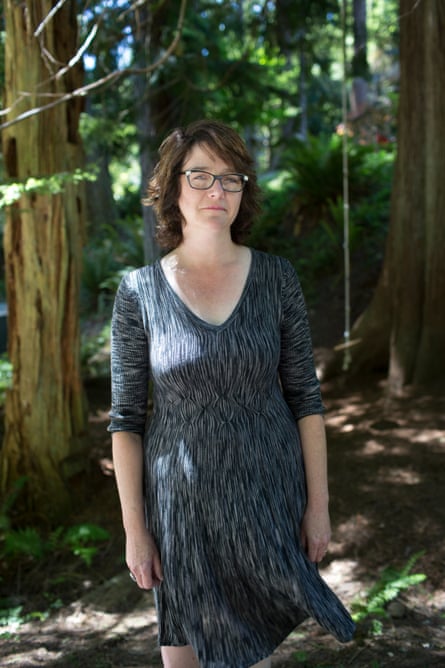
Liz Hjelmseth, 53, lives in Washington State with her husband and their 14-year-old daughter. She was eight when she was shot by her 16-year-old brother at their family home in Montana
The day I was shot, it was Halloween. It was a pretty exciting day – I was going to be able to go trick or treating by myself. I came home and found my brother had been scratched by my cat. He was pretty angry and I put myself between him and the cat. It was hunting season and we had our guns just out in our front porch area. My brother went and got one of them. I think he was trying to scare me – isn’t it sad that I don’t know?
He told me he was going to shoot me, then pointed the gun at me. It was a 30-30 rifle, common for hunting large game, elk. A very powerful rifle. I was sitting down, crouching in the corner of the room and the bullet went through my arm, then through my leg. I heard later that the bullet lodged in the wall. That single shot almost blew my leg off.
Luckily for me, my sister was home. She took me to our family practice doctor, who bundled me up and put me in the back of his station wagon. His wife drove me 20 miles to the hospital in Bozeman, where the team of doctors saved my life.
When I woke up after being unconscious for a week, there was a story established that my brother was playing with a gun and it accidentally went off and I was just in the wrong place at the wrong time. No one knew about the fight with the cat.
I didn’t tell anybody the truth about what happened. At the time, I was really afraid for my brother and felt protective of him. Maybe that’s a victim thing, I don’t know.
I have never talked to him about it. People ask why all the time and I can’t say. Sometimes, I feel that if I start talking to him about it, it would rip too big a hole in our relationship. I don’t know what the aftermath of something like that is, living a lie for that long.
When I was around 30, I had a bit of a breakdown and went into therapy. My therapist thought it would be a good idea for me to clear up the misunderstanding and tell my parents the truth. They said they’d felt that maybe it had not been an accident but didn’t push it. It is hard to have uncomfortable conversations.
My sciatic nerve was taken out by the bullet, so I don’t have any control over the lower bottom half of my leg. I wear a brace. I had physio for years and I walk very well. People usually can’t tell that there’s anything wrong with me unless I get tired. But inside, I’m still tender. Even today, when I knew I was going to be doing this interview, I cried taking my shower, knowing I’d have to talk about it again.
There are lots of activities that I can’t do. Everybody skis here and I can’t do that and I can’t run. These are the two things, oddly enough, that my daughter loves to do. These are things I don’t get to experience with her. She’s on a ski team and I’ve never seen her race, because I just can’t get to the races. I live in fear of getting older and that, at some point, I might not be able to walk.
When my daughter was eight, I would just look at her and see how tiny she was, how innocent she was. When she was small, before she went over to anyone’s house, I had a conversation with the parents, to make sure there were no guns in the home that weren’t stored properly. Only once did I have someone say: “We have a handgun next to our bed” and I said: “Well, I’m sorry but my daughter can’t play with your child.”
My husband hunts and owns guns, but we store them properly in locked safes. In my opinion, that would have prevented my getting shot, if my parents had had proper gun storage. It wasn’t even a consideration, growing up, but now people know. I do work contacting people about getting safe gun legislation, and child access prevention legislation. But it’s not really going anywhere. It’s a crazy place and time we’re living in right now.
I did get to hold the gun that shot me. My sister owns it now and last time I visited, her husband asked me if I wanted to hold it and I did. I’d never held a gun before. I was struck by how heavy it was. To pick something up like that – it’s a very determined effort.
Kathy’s photograph captured something that’s still a little tender for me. You get over it, you move on and I have a wonderful life – but there are some raw edges. And sometimes they catch. FC
James Armstrong: ‘The last thing I remember my friend saying as he lay there was, ‘I don’t want to die’

James Armstrong, 28, lives in Bozeman, Montana. He was shot four years ago while leaving a house party. He lost a leg. His friend, who was also shot that night, died.
I find Kathy’s photo of me hard to look at. It was taken on the spot where I was shot and it’s a reminder of how much my life changed there that night. In the photo, my prosthetic leg is in my hand.
I was shot at 4.30am after a friend’s birthday party. That night, we’d gone out, we had a good time, we all had some drinks. Then we came back to a friend’s house. It was when a group of us were leaving that someone threw a beer bottle. So I yelled something. I said: “Who threw that?”, because, you know, there were a couple of girls with us. And this guy walks into the light and says: “I’m sorry, I’m sorry, don’t want to start any trouble.” He put both his hands up. From there, he got close enough to hit me in the mouth. Then he turned and ran away, so fast he kind of stumbled. He lived next door to where the house party was and he just ran home as fast as he could. My brother grabbed me around the waist and said: “It’s not worth it, let him go.”
We continued to head towards the truck. The next thing I know, I see the guy coming back. All of a sudden, he fires a shotgun round into the ground. I said: “What are you gonna do now, are you gonna shoot me?” – and when I said that, he fired right into my leg. Then he turned around and fired right into my friend’s stomach.
Then he ran away again, leaving me and my friend lying on the asphalt.
It almost seemed surreal. How could this have happened? There were people screaming. My friend was screaming. My brother called the ambulance and it seemed like it took an eternity for it to get there.
The last thing I remember my friend saying as he lay there was: “I don’t want to die.” I didn’t find out he’d passed until a couple of days after. My doctors told everyone not to tell me. They wanted me to focus on my own recovery and not to have to worry about it. But when they told me I was still in hospital and it was really hard. I just couldn’t believe it. He was a good guy. There was a quote that one of my other friends came up with, from a song: “Everybody dies, but not everybody lives.” My friend did everything he ever wanted to do. He had no regrets. He was just a very good guy, a good dude.
I was bitter when it first happened. Now, I think that it was more of a wrong place, wrong time situation. During the trial, it all came out that the shooter was former military. His lawyers’ case was that it was PTSD. He went to prison, though. I think he knows that he made a mistake. I think he knows that he took someone’s life that didn’t need to be taken.
Before the shooting, I was working in the oil fields in North Dakota. It was all outdoors on an oil rig. A good job, but really hard, tough work. Now I do excavations, operate heavy equipment and I bar-tend on the side. It makes it difficult, only having one leg. It’s tough, it has its challenges. I get sores. At work, I have to be careful of walking on uneven surfaces, because I lose my balance a lot more easily. With some of the equipment, you have to use your feet and I only have one foot.
I have to put my prosthetic on every morning, I have to take it off at night, and I have to take it off to take a shower. I stand on one leg a lot.
I have a girlfriend, and we’ve spoken about the shooting, but it’s one of those things that’s hard to talk about and I don’t really like to.
I still live in Bozeman and the place I was shot is about a block off from the main road. When I go to the actual spot, it’s weird to look at it and think, this is where I lay not knowing if I was going to live or die. This is the last place I saw my friend. FC
Antonius Wiriadjaja: ‘I got into this horrible mess because of violence against a woman’
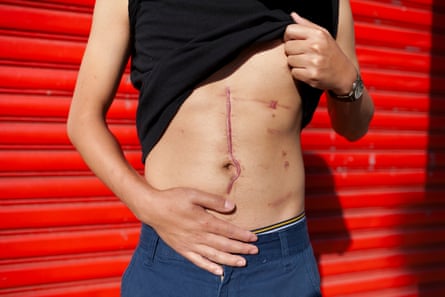
Antonius Wiriadjaja, 33, teaches interactive media at New York University’s Shanghai campus. He was working as a researcher at the New York campus when he was caught in a shooting in Brooklyn at the age of 29
The biggest thing for me has been the realisation that a lot of problems with gun violence have a relationship to violence against women. The reason I got into this horrible mess is because as I was walking down the street, a man was shooting at a pregnant woman. They had their own dispute and I wasn’t part of it, I was an innocent bystander to violence against this woman. It’s something we desperately need to address here in the US.
It was the 5th of July, and because it was the day after Independence Day I had the day off. I had promised my friend that I would help her move. It was a 90-degree weather day, and usually I bicycle everywhere but because it was so hot I decided to walk to the subway. It was 2pm, and as I walked I thought I heard fireworks, which is to be expected the day after Independence Day. But when I looked down I was actually bleeding from my chest, and I realised that I’d been shot.
I found cover. The bullet went through my chest and it travelled to my stomach, and I was in a lot of pain. Like somebody kneed me in the gut and also hit me in the back. It was really difficult to breathe, it felt like daggers were stabbing into my chest every single time I took a breath. I remember looking into the sky and I saw the light going through the leaves of the trees, and thinking, “Wow, it’s so peaceful now.” The birds were chirping. I was starting to lose consciousness, and I was helped by some of my neighbours – one, a barber, put his hand over my chest and pushed down to make sure I didn’t bleed out, and a woman kept talking to me, making sure that I stayed awake.
Then the ambulance came. I fell into a four-day coma, and I woke up and I was the happiest person on Earth, because I’d survived.
The week before I got shot, I was asked to start teaching at NYU in New York. And I actually did end up teaching in the fall, but not until October, so I had more time to recuperate. But there have been two big long-term effects. The first one is lasting pain. I lost a bunch of organs including my spleen, so I have to get vaccinated for things like the flu more often. I also had PTSD – it was 17 months or so before I was even remotely prepared to walk down the street without getting scared and nervous.
The other knock-on effect is the financial burden. When I left hospital, the first thing I got was a medical bill for $100,000. I was very lucky because I have health insurance for my work, but I couldn’t work for several months, I was in physical therapy. I took a full-time gig in Shanghai in part to pay off a lot of my bills.
When I saw the picture [above] I was struck by how dramatic it is - the scar was still pink, and there’s the blood [red] awning in the background. I remember thinking, “Wow, that’s actually very beautiful.” I’d never felt that way about the scar before. FC
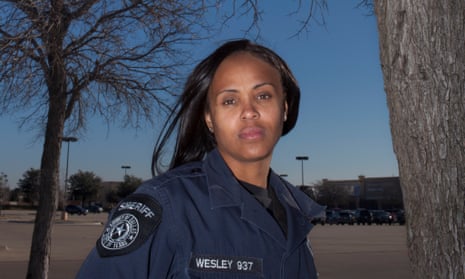




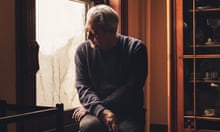
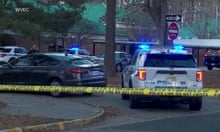

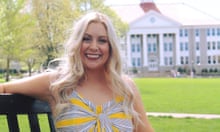

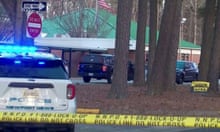
Comments (…)
Sign in or create your Guardian account to join the discussion